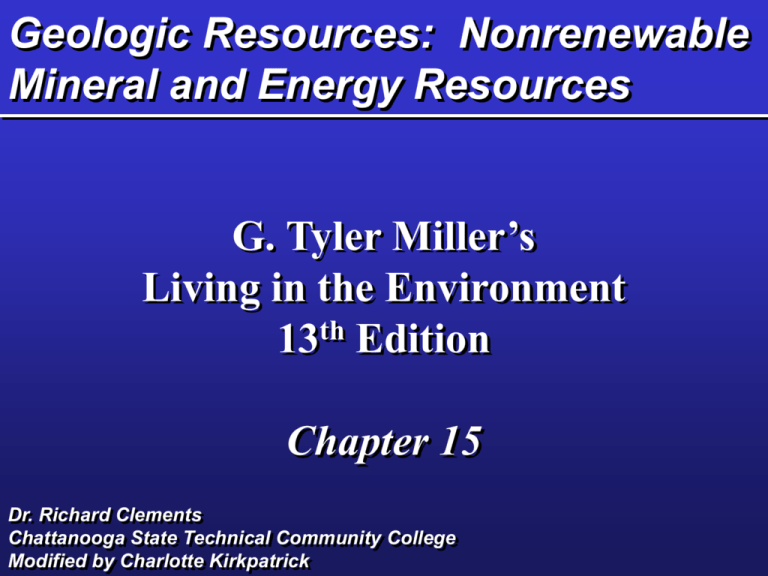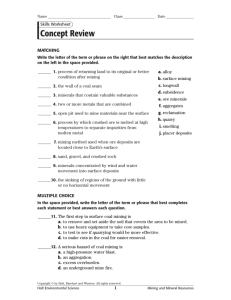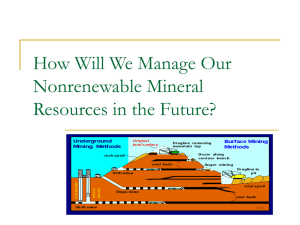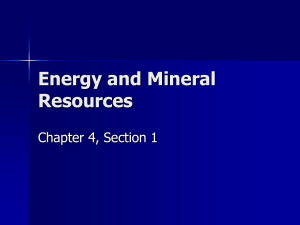ch15_lecture - La Habra High School
advertisement

Geologic Resources: Nonrenewable Mineral and Energy Resources G. Tyler Miller’s Living in the Environment 13th Edition Chapter 15 Dr. Richard Clements Chattanooga State Technical Community College Modified by Charlotte Kirkpatrick Key Concepts Types of mineral resources Formation and location of mineral resources Extraction and processing of mineral resources Increasing supplies of mineral resources Major types, acquisition, advantages, and disadvantages of fuel resources Why mine minerals? Nature of Mineral Resources Mineral resources: concentration of naturally occurring material in or on the earth’s crust that can be extracted and processed into useful materials at an affordable cost Metallic: iron, copper , aluminum Non-metallic: salt, clay, sand, phosphates, soil Energy resources: Coal, oil, natural gas, uranium General classification of mineral resources Fig. 15-2 p. 339 Nature and Formation of Mineral Resources Magma: magma flows to the surface at divergent and convergent plate boundaries it cools, and crystallizes into mineral containing igneous rocks. Hydrothermal: hydrothermal vents allow seeping of metal-bearing solutions to cool and their dissolved minerals to form hydrothermal ore deposits. Manganese nodules: cover 25-50% of the ocean floor very concentrated form of manganese and other important metals. Hydrothermal vent communities and deposits Black smoker White smoker Sulfide deposit Magma Tube worms White crab White clam Figure 15-3 Page 340 Slide 3 Ores From Sedimentary and Weathering Processes Sedimentary processes: Placer Deposits: form as deposit settle out as flowing water slow down:gold Evaporites: water evaporates from inland seas or lakes with no outlets and concentrations of dissolved salts increase and precipitate out for form evaporites mineral deposits such as Salt, borax, and sodium carbonate Weathering: moving water removes soluble ions and leaves behind ions that form Residual deposits of metal ores:Iron and Bauxite ore Salt mine from Sal Island Finding Nonrenewable Mineral Resources Satellite imagery Aerial sensors (magnetometers) Gravity differences Core sampling Seismic surveys Chemical analysis of water and plants Removing Nonrenewable Mineral Resources Surface mining: basics Overburden: soil and rock removed by stripping away by mechanized equipment Spoil: Waste material discarded from overburden Removing Nonrenewable Mineral Resources: Surface Mining Types Open-pit: land is dug up into a large hole to remove deposits of mineral ores and sandstone, gravel and stone. Dredging: removal of minerals from the ocean floor Removing Nonrenewable Mineral Resources: Surface Mining Types (cont.) Area Strip Mining: flat terrain mining, removal of overburden and in strips and if not restored spoil banks left behind Contour Strip Mining:same as above except on hilly terrain and leftover is a erodable wall of dirt called a high wall. Mountain Top Removal: explosives and large machinery used to remove mountain tops to expose seams of coal underneath. Very environmentally damaging. Types of Surface Mining Open Pit Mine Figure 15-4 (1) Page 341 Dredging Slide 4 Figure 15-4 (2) Page 341 Slide 5 Contour Strip Mining Area Strip Mining Figure 15-4 (3) Page 341 Figure 15-4 (4) Page 341 Slide 6 Slide 7 Removing Nonrenewable Mineral Resources Subsurface mining: removes minerals too deep for surface mining Room and pillar Longwall Mine shafts and tunnels Types of Subsurface Mining Figure 15-5(1) Page 342 Underground Coal Mine Figure 15-5 (2) Page 342 Room-and-pillar Slide 9 Slide 8 Longwall Mining of Coal Figure 15-5 (3) Page 342 Slide 10 Environmental Effects of Extracting Mineral Resources Fig. 15-6 p. 343 Environmental Effects of Processing Mineral Resources Ore mineral: Extracted from ore, contains the desired metal Gangue: Also extracted from ore, waste material Tailings: Piles of gangue waste left behind, allows toxic metals to reach groundwater and surface water supplies Smelting: Used to separate the metal from the other elements in the ore mineral. See Case Study p. 345 One effect of tailings left behind Above: A simplified diagram showing natural cyanide degradation processes at the tailings storage facilities. 1. Waste Rock Embankment. 2. Decant pond. 3. Natural ground. Typical Lifecycle of a metal resource Smelting Separation of ore from gangue Melting metal Metal ore Conversion to product Recycling Discarding of product Surface mining Figure 15-8 Page 344 Scattered in environment Slide 13 Acid Mine Drainage Fig. 15-7 p. 344 Environmental Effects of Using Mineral Resources Disruption of land surface Subsidence: sinking of the land Erosion of solid mining waste: tailings, spoil banks Acid mine drainage: pollution of water sources as rainwater seeps into ground and surface water Air pollution: smelters, toxic emissions Storage and leakage of liquid mining waste: smelters, holding ponds Supplies of Mineral Resources Economic depletion Depletion time: shortened by recycle, reuse, reduce, improved technology, new discoveries, higher prices Reserve-to-production ratio: the number of years that proven reserves of a particular nonrenewable mineral will last at current annual production rates. Fig. 15-9 p. 346 Supplies of Mineral Resources Foreign sources: we are highly dependent on sources outside the U.S. Economics:mine higher grade ore first, lower grade ores are more environmentally damaging. Most of the environmental costs for mining are not included in the prices for processed metals and products Follow normal supply and demand Mining law of 1872: hard rock minerals may be mined without paying royalties, by patenting parcels of land, no environmental cleanup required, World Mineral Map World Mineral Reserves Environmental concerns Environmental concerns: 5-10% of world energy use is for extraction of minerals. Major contributor to air and water pollution. Largely determined by mineral content or grade. Mining on Public lands; national forests, parks, resource lands and wilderness. Supplies of Mineral Resources Mining lower grade ores: New earth-moving equipment, improved techniques for removing impurities, technical advances in mineral extraction and processing Mining the ocean: Many mineral elements found in seawater, sediments and deposits on the shallow continental shelf, hydrothermal ore deposits, and manganese rich nodules Finding substitutes: Mainly plastics and ceramics Evaluating Energy Resources Renewable energy:Energy resources that can be used sustainably and be available for future generations. Non-renewable energy: Energy that has a finite supply and the only way to increase supply is through conservation techniques. Environmental effects: Use of mostly nonrenewable energy resources has resulted in an increase in air and water pollution, land disruption, and greenhouse gas emissions. Evaluating Energy Resources World Fig. 15-12 p. 351 U.S. Nuclear power 6% Hydropower, geothermal, solar, wind 7% Natural Gas 12% Biomass 11% Coal 21% Oil 32% World Figure 15-12 (1) Page 351 Slide 17 Nonrenewable: 82% Renewable: 18% Nonrenewable:91% Renewable : 9% Evaluating Energy Resources Future availability: depends largely on how we use the resources. Cost: affected by the promotion of subsidies, and tax breaks, availability of resource Net Energy Yield Net energy yield: Usable amount of high-quality energy available from a given quantity of an energy resource. Determined by the total energy available from a resource minus the energy needed to find, extract, process, and bring to consumers. Figured by estimating the total energy available for use over its lifetime minus the amount of energy 1. used (1st law), 2.automatically wasted (2nd law), and 3. Unnecessarily wasted for finding, processing, concentrating, and transporting. Net Energy Ratios High-Temperature Industrial Heat Surface-mined coal Underground-mined coal Natural gas Oil Coal gasification Direct solar (highly concentrated by mirrors, heliostats, or other devices) 28.2 25.8 4.9 4.7 1.5 0.9 Figure 15-17 (2) Page 354 Slide 25 Transportation Photovoltaic (solar) cells Natural gas 4.9 Gasoline (refined crude oil) 2-10 4.1 Biofuel (ethyl alcohol) 1.9 2-13 Coal liquefaction Oil shale 1.4 1.2 Figure 15-17 (3) Page 354 Figure 15-17 (4) Page 354 Slide 26 Slide 27 Fuel Resources Over Time 100 Contribution to total energy consumption (percent) Wood 80 Coal Natural gas 60 Oil 40 Hydrogen Solar 20 Nuclear 0 1800 1875 1950 Year 2025 2100 Figure 15-16 Page 353 Slide 23 Some Important Energy Sources Fig. 15-10 p. 350 Oil Petroleum (crude oil): oil as it comes out of the ground, is a thick liquid consisting of hundreds of combustible hydrocarbons along with small amounts of sulfur, oxygen, and nitrogen impurities. Formed from decomposition of dead organic matter from plants (plankton) and animals buried under lake and ocean sediments from 2140 million years ago (MYA) Oil Primary recovery:Involves drilling a well and pumping out the oil that flows by gravity into the bottom of the well. Secondary recovery: After flowing oil is removed water can be infected into a nearby well to force some of the heavy oil to the surface. Tertiary recovery: steam or carbon dioxide gas are injected to remove approximately 10% of the remaining heavy oil Oil Oil and Natural gas are usually found together trapped in a dome deep within the earth’s crust. Heavy Crude oil is too expensive to extract so most wells are only getting about 35% of the oil out. Drilling causes little land damage yet it always involves some oil spills on land and at sea and the harmful effects of using associated with extraction, processing, and using oil Oil Refining: based on boiling points components are removed at various levels in a giant distillation column. The most volatile components with the lowest boiling points are removed at the top. Transporting: by pipeline, trucks or ships Petrochemicals: Products of oil distillation that are used as raw materials in industrial organic chemicals, pesticides, plastics, etc. Oil refining by Distillation Most volatile Fig. 15-18 p. 355 Who has the World’s Oil? • Oil reserves are identified deposits from which oil can be extracted profitably at current prices with current technology. • OPEC contains 67% of the world’s crude oil reserves (see bottom of page 355). Mainly in Saudi Arabia (26%) • The remaining is found in Latin America, Africa, the former Soviet Union, Asia, the United States and Western Europe. North American Energy Resources Fig. 15-20 p. 356 Oil Use in the U.S. • Most oil drilled in the U.S. comes from offshore drilling in the Gulf of Mexico and form drilling in Alaska’s North Slope. • U.S. only produces 3% of the world’s oil yet uses 26% of the crude oil extracted each year. • Therefore, much of our oil is imported each year, mainly from the Persian Gulf • 1973 imported 36%, 2001 imported 55% and predicted to import 61% by 2010. Oil Usage and How Long Will it Last? • We are not currently running out of oil!! • However, our known reserves of oil are limited and if we continue to use them at current rates we may have only 53 years left. And if we increase usage by only 2% per year only 42 years of oil are left. • Undiscovered oil supplies might add another 20-40 years to the global supplies. • See page 358 Consumption (million barrels per day) Oil Consumption 60 History 50 Projections Developed countries 40 30 Developing countries 20 10 0 1970 1980 1990 2000 2010 2020 Year Figure 15-19 Page 355 Slide 29 Pros and Cons of Oil Advantages Ample supply for 42–93 years Low cost (with huge subsidies) High net energy yield Easily transported within and between countries Low land use Efficient distribution system Disadvantages Need to find substitute within 50 years Artificially low price encourages waste and discourages search for alternatives Air pollution when burned Releases CO2 when burned Moderate water pollution Figure 15-26 Page 361 Slide 37 Oil Shale and Tar Sands Oil shale: shale Keragen must be refined before use and to be sent by pipeline rock that contains oil. to the refinery it must be heated Keragen: actual to increase flow and processed substance locked in the to remove impurities. shale, converted to oil Bitumen must be removed, Tar sand: sand purified, and chemically that contains clay, sand, upgraded into a synthetic water and bitumen crude oil suitable for refining. Bitumen: heavy Canada has a very rich Tar oil with a high sulfur sand supply and has been content (high sulfur using it since 1978 oil) Pros and Cons of Shale Oil and Tar Sands Natural Gas 50-90% methane with small amounts of heavier gases (propane,butane) and hydrogen sulfide Conventional gas:Lies just above crude oil reservoirs Unconventional gas: found by itself in underground sources. Not economical to extract, yet. Ex. Methane hydrate: composed of small bubbles of natural gas trapped inice crystals deep under the arctic permafrost and beneath deep ocean sediments. Natural Gas Liquefied petroleum gas (LPG): When a natural gas field is tapped the propane and butane are liquefied and removed and stored in pressurized tanks mainly for use in rural areas not serviced by gas pipelines. Liquefied natural gas (LNG):The remainder of the gas is dried, cleansed of impurities, and pumped into pressurized pipelines (natural gas at your homes). Then, if exposed to a very low temperature, it can be converted into LNG. And if refrigerated it can be transported by tankers Approximate 200 year supply Pros and Cons of Natural Gas Coal Primarily strip-mined Used mostly for generating electricity Enough coal for about 1000 years Highest environmental impact Coal gasification and liquefaction Coal: Stages of Formation Fig. 15-30 p. 363 Burning Coal More Cleanly Fluidized-Bed Combustion Fig. 15-32 p. 364 Nuclear Energy Fission reactors Uranium-235 Potentially dangerous Radioactive wastes Refer to Introductory Essay p. 338 Fig. 15-35 p. 366 The Nuclear Fuel Cycle Fig. 15-36 p. 367 Dealing with Nuclear Waste Low-level waste High-level waste Fig. 15-40 p. 370 Dealing with Nuclear Waste Underground burial Disposal in space Fig. 15-40 p. 370 Burial in ice sheets Dumping into subduction zones Burial in ocean mud Conversion into harmless materials Nuclear Alternatives Breeder nuclear fission reactors Nuclear fusion New reactor designs Storage Containers Fuel rod Primary canister Ground Level Unloaded from train Personnal elevator Air shaft Nuclear waste shaft Lowered down shaft Fig. 15-42 p. 376 Overpack container sealed Underground Buried and capped Groups for Presentations (Period 4) Group #1 Passive Solar Heating System Lindsey Whang, Michelle Manzer, Jake McCune, Group #2 Active Solar Heating System Tim Hawes, White Xie, Kathy Chou, Rachel Kim Group #3 Solar Thermal Systems Sabaha Khakoo, Christine Buzan, Bryan Koorstad Group #4 Electricity from Solar Cells Christopher Gray, Andrew Plaza, Riley Thornburgh Group #5 Hydroelectric Power Lauren Comise, Michael Shin, Kate Wyrick Group #6 Electricity from Tides and Waves Ryan Kim, Alex Conrad, Anish Gala Group#7 Heat stored in Tropical Oceans Jessica Shim, Sujan T., Timothy Tran and Solar Ponds Group #8 Electricity from Wind Michael Wurth, Patrick Goh, Jennifer Chow Group #9 Biomass plantations and burning wood Christine Kobayashi, Karthick Bhaskaran, Henry Kaplan Group #10 Burning Agricultural wastes Jason Perecko, Ryan Haggerty, Jenn Hori Group #11 Solar Hydrogen Jimmy Jea, Ernie Chen, James Bai Group #12 Geothermal Energy Robin Kim, Eileen Ong, Nikhil Gupta Groups for Presentations (Period 5) Group #1 Passive Solar Heating System Danielle Reyes, Bhumi Desai, Hershel Mehta Group #2 Active Solar Heating System Christopher DeLeon, Linh Duong Group #3 Solar Thermal Systems Hannah Cole, Rachel Nishimura Group #4 Electricity from Solar Cells Brent Reed, Sung Jin, Dale Stoica Group #5 Hydroelectric Power Nirlai Shah, Colin Webber, Scott Shin Group #6 Electricity from Tides and Waves Daniel Chung, Paul Kang Group#7 Heat stored in Tropical Oceans Andrew Murase, Nicole Uchida and Solar Ponds Group #8 Electricity from Wind Kacey Kim, Janet Lee, Michelle Lee Group #9 Biomass plantations and burning wood Elliot Kim, Eunice Choi Group #10 Burning Agricultural wastes Kasen Bien, Rachel Yang Group #11 Solar Hydrogen Christie Hsu, Zain Lalani, Priya Gohil Group #12 Geothermal Energy Kevin Wang, Sarah Ortiz, Justin Wang Groups for Presentations (Period 6) Group #1 Passive Solar Heating System Jane Huh, Brandon Wong, Harrison Lam, Alison Ozaki Group #2 Active Solar Heating System Justin Phan, Mackenzie Chang, Christopher Guevara, Arti Kothari Group #3 Solar Thermal Systems Alexander Kim, Tiffany Lai, Riye Takahashi Group #4 Electricity from Solar Cells Alyssa Pasternack, Brandon Liu, Dayanita Ramesh Group #5 Hydroelectric Power Dionne Bang, Vivian Wu, Namrata Doshi Group #6 Electricity from Tides and Waves HaYon Chun, Kathy Li, Emma Hartman Group#7 Heat stored in Tropical Oceans Sophia Chou, Nataya Chayasriwong, Marko and Solar Ponds Cristal Group #8 Electricity from Wind Kyle Barnes, Mark Kim, Christopher Patuwo Group #9 Biomass plantations and burning wood Nicholas Lowe, Joshua Ahn, Isabella Luong Group #10 Burning Agricultural wastes Andrew Tran, Patricia Shnell, David Lin Group #11 Solar Hydrogen Jason Su, Rachel Chen, Grace Yee Group #12 Geothermal Energy Alex Norby, Brandon Hui, Gerardo Saucedo






